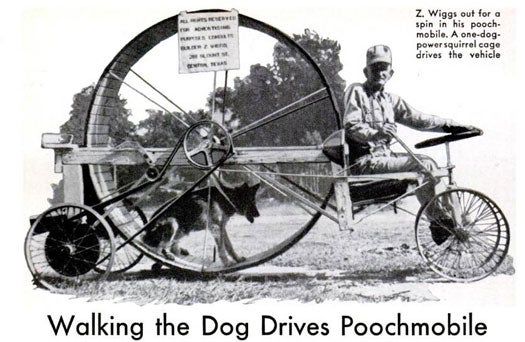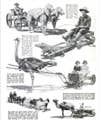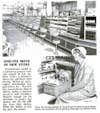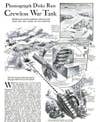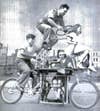Every month for the past 138 years, we’ve showcased inventions and concepts for mechanisms aimed at improving life. Sometimes this meant curing cancer, other times it meant having fun, and on rare (and scary) occasions, it meant building something because you could.
For every airplane, computer or chemical weapon appearing in our archives, there are a ton of other inventions that are, to put it bluntly, rather pointless. At best, they’re well-intentioned but a little impractical. Let’s take a look, shall we?
Click to launch the photo gallery.
We wouldn’t be surprised if the question of “why not?” prompted Charles Steinlauf to strap a sewing machine and a steering wheel onto a bike. What problem does a sewing machine bicycle actually solve? Why craft such a high-maintenance, Cirque de Soleil-worthy family vehicle when you can just buy a car? It might not be the most useful mechanism, but it landed him a magazine spread – and a couple trips to the hospital, judging by the precariousness of balancing on such a machine.
In 1917, Max Rothfeld proposed converting a piano into a vacuum cleaner by hooking up the instrument to a patented dust filterer. People might say that necessity is the mother of invention, but in this case, we’d venture that the inspiration came more from boredom. Not everyone would think to power a vacuum using piano pedals, but then again, almost anyone would sweep the old-fashioned way before hauling a piano vacuum around the house.
It gets stranger, especially during the late 1920s and 1930s, when times were hard and people were looking for diversions. Within our pages, we’ve found a bicycle that churns butter, a wagon run by a tamed crocodile, and a zeppelin with a built-in hospital (hello radiation exposure!). These concepts, along with the dog-powered “Poochmobile” and the jazz-responsive mushroom farm, are more comical in retrospect than the inventors probably intended.
These inventions might not have changed history, and for all we know, they might not even have worked beyond trial periods and personal use. What we can say, though, is that they made as laugh, and a good chuckle will always be more useful than a crocodile-powered cart.
Click through our gallery to read more about our favorite impractical inventions.
Combination Piano-Vacuum Cleaner: July 1917
A piano isn’t just a musical instrument. According to Max Rothfeld, of Philadelphia, it could double as a vacuum cleaner. Step one, substitute Rothfeld’s patented dust filtering attachment for the air pipe leading to the piano bellows. Hook the dust filterer onto the air motor, work those pedals, and watch in awe as your piano sucks up dirt in the surrounding area. If your floor’s already clean, use the vacuum attachment to de-clog the crevices in your piano. Invention of the year, everyone! In all seriousness, though, how much would you have to hate old-fashioned sweeping to see a stationary vacuum as the better alternative? Read the full story in “Utilizing Your Player Piano as a Vacuum Cleaner”
Hail Cannons: October 1919
Few things would be more convenient than the ability to control the weather, but the technologies we’ve developed toward that end haven’t exactly made life easier. Hail cannons, which predate the invention of gunpowder, experienced a brief revival in the late 19th century when residents of Styria (in modern-day Austria) devised a special gas-based mortar supposedly capable of preventing hail. By the year 1900, more than 10,000 hail guns had cropped up across Western Europe. Given their popularity, it’s a shame that the cannons proved useless. Scientists commissioned by the Austrian and Italian governments dismissed the weather guns after finding that they failed to “agitate” the air or change the composition of clouds. Even if the mortar could affect one oncoming storm, it was highly unlikely that they could prevent future hailstorms altogether. Read the full story in “Jostling the Clouds to Change the Weather”
Growing Mushrooms with Electricity: April 1923
We all remember that scene in Frankenstein where the monster awakens amidst flashes of lightning, but did you know that mushrooms could be stimulated the same way? At least that’s what A.G. Hupfel Jr. claimed when he built his mushroom farm in a dismantled New York City brewery. He believed that artificial fogs and thunderstorms, as well as “a drumming kind of ‘jazz music,'” would help mushrooms grow to the size of the fungal “hat” pictured left. Twice a week, the old brewery boiler would pass steam through the refrigerating apparatus, creating the fog needed for “irrigation.” To help his mushrooms breathe, Hupfel generated electricity from static machines, which would produce oxygen in the same way lightning releases it from the air (earlier, he’d observed that wild mushrooms seemed to grow best during lightning storms). Finally, the jazz music produced a drumming beat that the mushrooms were supposed to respond to. Somehow (Hupfel wouldn’t explain it to us), the rhythmic noise would speed up the formation of plant cells, and thus, the formation of mushrooms. Read the full story in “Tiny Thunderbolts Help Mushrooms Grow”
Beast-Drawn Carriages: November 1924
Who needs a car when they can have a wagon drawn by crocodiles? Granted, it’d take some serious badassery to capture, strap down and subdue a crocodile for that purpose, but it looks like one California farm worker managed to pull it off. If you were up to the task, you could also harness an ostrich to a carriage for children. Not a bird person? A couple of Russian wolfhounds would also make for a splendid team. We also suggested procuring a five-team span of billy goats or a camel — no doubt some of our readers had a few of those standing around. Read the full story in “Strange Beasts of Burden”
Ingenious Farm Gadgets: September 1925
Farming’s hard work. Even the most mundane tasks, like churning butter or grinding corn, can take hours — unless you’re the proud owner of a bicycle-powered butter churner or a corn-grinding windmill. The miniature mill, located in Kansas, ground corn bit by bit during breezy days, but we get the feeling that doing the work by hand would be more efficient than waiting for winds powerful enough to allow the machine to do a thorough job. As much as we want to believe in a bike that can churn butter — especially for the exercise it would provide — we’d be more impressed with the device if it could do its work on a larger scale. Read the full story in “For Farm and Garden”
Airship Hospital: July 1930
Back when sunshine and high altitudes were commonly seen as cure-alls for various diseases, Charles L. Julliot, a French lawyer, proposed building a flying hospital for patients who could benefit from the “natural exhilaration of an air trip.” Dr. Karl Arnstein, vice president and chief engineer of the Goodyear-Zeppelin corporation, described how airships would come with a celluloid bubble sanatorium where patients could rest, socialize, and consult doctors while taking in heavy doses of Vitamin D. Hospital airships could remain aloft for weeks on end if an accompanying airplane flew in supplies and communicated with the ground. As magical as a zeppelin hospital sounds, the risk of radiation exposure would probably prevent people from taking advantage of a flying hospital today. Read the full story in “Hospital on Airship May Sweep Patients Above Clouds in Quest of More Sunlight”
Automated Grocery Store: October 1933
Self-service grocery stores aren’t what they used to be. In 1933, a grocery store in Los Angeles represented the pinnacle of leisure for a housewife. Instead of roaming around the aisles, all she had to do was sit down on a bar stool and select merchandise from moving shelves. Shelves made a complete circuit every eight minutes. Sure, the process sounds relaxing, but something about the concept just reeks of glorified laziness. If you’re going to eat a whole tube of Oreos in one sitting, the least you can do is walk ten feet down the snacks aisle looking for it. Automated grocery stores never really took off, but variations of the idea popped up throughout the years. In 1937, a self-service grocery store in Memphis, TN, allowed customers to order their merchandise by sticking keys into slots next to the items they wanted. By the time they finished, a master control mechanism would have recorded everything they wanted. The goods would come out of a chute attached to storage shelves and a calculator would total the cost. Read the full story in “Shelves Move in New Store”
War Tank Run by Phonograph: November 1934
After discovering that phonographs can record mechanical movements as well as sound, a French scientists proposed designing crew-less tanks that could be maneuvered using pre-recorded instructions. Four disks would be used for communicating orders. The first one would start and stop the tank, the second would steer it, the third would control speed and the fourth would be in charge of the gun. In retrospect, this innovation presents more problems than it actually solves. The records would probably get stuck while the tank drove over unpaved terrain. On-the-spot thinking would be irrelevant – if the enemy did something we didn’t predict while programming the tank, we’d be dead. To this day, we’re still figuring out how to optimize automated vehicles. If the Mars Rover can’t speed around, how much more difficult would the process be for a tank driven by phonographs? Read the full story in “Phonograph Disks Run Crewless War Tank”
Water Skiing Just Got Easier: October 1937
Want to water ski faster? Get ahold of these oval sails, step into your floating footgear, and let the sea winds take you away. These oval-shaped double sails, which were attached by rods held at shoulder level, undoubtedly required impressive upper body strength, as well as some know-how in steering (it’s harder than it looks). Not surprisingly, the arrival of jet skis diminished the appeal of this unnamed double sail sport. Read the full story in “Double Sails Propel Bather on Water Skis”
Sewing Machine Bicycle: October 1939
In 1939, we declared Charles Steinlauf’s “Goofybike” the world’s weirdest bicycle — and for good reason. As the photo shows, the bike could carry four people and a sewing machine. The inventor is pictured at the top of the bicycle, where he maneuvers the machine using an automobile steering wheel. While his daughter sits on the handlebars and his ever-industrious wife finishes her sewing, their son huffs and puffs at the pedals. The legs of the sewing machine keep the bike aloft when it’s not being used. Family outings don’t get better than this! Read the full story in “Bike Keeps Family in Stitches”
Poochmobile: November 1939
Again, who needs a car when you can have a vehicle powered by an exceptionally strong pet? The so-called “Poochmobile,” invented by eighty year-old dog trainer Z. Wiggs, applied the squirrel cage principle to its primary wheel. While the dog ran, a belt and pulley mechanism would turn the rear drive wheels, which were in turn controlled by the driver’s “gearshift” lever in the front. Our question is, how did Wiggs get his dog to run around around in that wheel? Dogs aren’t hamsters — wouldn’t most breeds just sit there, whining and confused? Read the full story in “Walking the Dog Drives Poochmobile”
